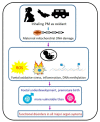Particulate Matter, an Intrauterine Toxin Affecting Foetal Development and Beyond
- PMID: 34066412
- PMCID: PMC8148178
- DOI: 10.3390/antiox10050732
Particulate Matter, an Intrauterine Toxin Affecting Foetal Development and Beyond
Abstract
Air pollution is the 9th cause of the overall disease burden globally. The solid component in the polluted air, particulate matters (PMs) with a diameter of 2.5 μm or smaller (PM2.5) possess a significant health risk to several organ systems. PM2.5 has also been shown to cross the blood-placental barrier and circulate in foetal blood. Therefore, it is considered an intrauterine environmental toxin. Exposure to PM2.5 during the perinatal period, when the foetus is particularly susceptible to developmental defects, has been shown to reduce birth weight and cause preterm birth, with an increase in adult disease susceptibility in the offspring. However, few studies have thoroughly studied the health outcome of foetuses due to intrauterine exposure and the underlying mechanisms. This perspective summarises currently available evidence, which suggests that intrauterine exposure to PM2.5 promotes oxidative stress and inflammation in a similar manner as occurs in response to direct PM exposure. Oxidative stress and inflammation are likely to be the common mechanisms underlying the dysfunction of multiple systems, offering potential targets for preventative strategies in pregnant mothers for an optimal foetal outcome.
Keywords: PM; endocrine; foetal programming; in utero; neurological; preventative treatment; renal; respiratory.
Conflict of interest statement
The authors declare no conflict of interest.
Figures
Similar articles
-
In utero exposure to ultrafine particles promotes placental stress-induced programming of renin-angiotensin system-related elements in the offspring results in altered blood pressure in adult mice.Part Fibre Toxicol. 2019 Jan 28;16(1):7. doi: 10.1186/s12989-019-0289-1. Part Fibre Toxicol. 2019. PMID: 30691489 Free PMC article.
-
Effects of prenatal exposure to air particulate matter on the risk of preterm birth and roles of maternal and cord blood LINE-1 methylation: A birth cohort study in Guangzhou, China.Environ Int. 2019 Dec;133(Pt A):105177. doi: 10.1016/j.envint.2019.105177. Epub 2019 Oct 14. Environ Int. 2019. PMID: 31622906
-
Impact of ambient PM2.5 on adverse birth outcome and potential molecular mechanism.Ecotoxicol Environ Saf. 2019 Mar;169:248-254. doi: 10.1016/j.ecoenv.2018.10.109. Epub 2018 Nov 16. Ecotoxicol Environ Saf. 2019. PMID: 30453172 Review.
-
Preterm birth associated with maternal fine particulate matter exposure: A global, regional and national assessment.Environ Int. 2017 Apr;101:173-182. doi: 10.1016/j.envint.2017.01.023. Epub 2017 Feb 10. Environ Int. 2017. PMID: 28196630
-
Ambient air pollution and pregnancy outcomes: A comprehensive review and identification of environmental public health challenges.Environ Res. 2018 Nov;167:144-159. doi: 10.1016/j.envres.2018.07.008. Epub 2018 Jul 5. Environ Res. 2018. PMID: 30014896 Review.
Cited by
-
Maternal exposure to airborne particulate matter during pregnancy and lactation induces kidney injury in rat dams and their male offspring: the role of vitamin D in pregnancy and beyond.Kidney Res Clin Pract. 2024 Sep;43(5):648-662. doi: 10.23876/j.krcp.23.106. Epub 2024 Jan 2. Kidney Res Clin Pract. 2024. PMID: 39390622 Free PMC article.
-
Impact of short-term air pollution exposure on premature rupture of membranes in the North China Plain, 2015-2021: a multicity case-crossover study.J Glob Health. 2025 Jun 13;15:04165. doi: 10.7189/jogh.15.04165. J Glob Health. 2025. PMID: 40511528 Free PMC article.
-
Key Messages of the Iodine Deficiency Working Group (AKJ): Maternal Hypothyroxinemia Due to Iodine Deficiency and Endocrine Disruptors as Risks for Child Neurocognitive Development.Geburtshilfe Frauenheilkd. 2025 Mar 26;85(8):796-809. doi: 10.1055/a-2505-1944. eCollection 2025 Aug. Geburtshilfe Frauenheilkd. 2025. PMID: 40771831 Free PMC article.
-
Preterm Birth Enhances Ambient Pollution Toxicity: Oxidative Stress and Placental Function.Am J Respir Crit Care Med. 2022 Jan 1;205(1):10-12. doi: 10.1164/rccm.202110-2338ED. Am J Respir Crit Care Med. 2022. PMID: 34793683 Free PMC article. No abstract available.
-
Iodine Deficiency, Maternal Hypothyroxinemia and Endocrine Disrupters Affecting Fetal Brain Development: A Scoping Review.Nutrients. 2023 May 9;15(10):2249. doi: 10.3390/nu15102249. Nutrients. 2023. PMID: 37242131 Free PMC article.
References
-
- Stangenberg S., Nguyen L.T., Chen H., Al-Odat I., Killingsworth M.C., Gosnell M.E., Anwer A.G., Goldys E.M., Pollock C.A., Saad S. Oxidative stress, mitochondrial perturbations and fetal programming of renal disease induced by maternal smoking. Int. J. Biochem. Cell Biol. 2015;64:81–90. doi: 10.1016/j.biocel.2015.03.017. - DOI - PubMed
LinkOut - more resources
Full Text Sources


